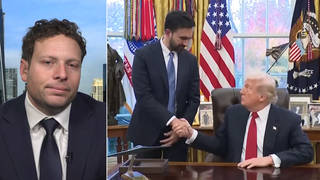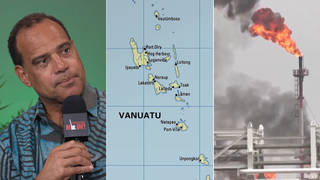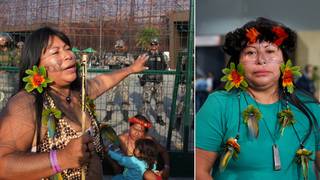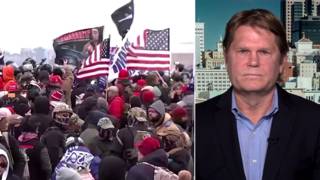
Topics
Guests
- Mike Germanfellow at NYU’s Brennan Center for Justice. From 1988 to 2004 he served as an FBI agent specializing in domestic counterterrorism.
- Bud Welchfounding president of Murder Victims’ Families for Human Rights. His daughter, Julie Marie Welch, was killed in the bombing of the Oklahoma City Federal Building on April 19, 1995.
As thousands head to the South Carolina state Capitol to honor church victim massacre Rev. Clementa Pinckney, a new study finds white supremacists and other non-Muslim fanatics have killed far more people in the United States since 9/11 than Muslim extremists. According to the research center New America, 26 people have been killed in jihadist violence in the U.S. since 9/11, but 48 people have been killed in attacks by right-wing groups. Despite the intense focus by the Obama administration on Muslim communities, non-Muslims have carried out 19 terrorist attacks since September 11, 2001, while Muslims have been responsible for only seven. We are joined by two guests: Mike German, a fellow at NYU’s Brennan Center for Justice and former FBI agent specializing in domestic counterterrorism; and Bud Welch, whose daughter, Julie Marie Welch, was killed in the bombing of the Oklahoma City Federal Building on April 19, 1995.
Transcript
NERMEEN SHAIKH: In South Carolina, thousands of mourners lined up at the state House to pay tribute to the Reverend Clementa Pinckney, a state senator and the Emanuel AME Church pastor, who was among the nine victims killed last week at Bible study in Charleston. Pinckney’s body lay in state ahead of his funeral on Friday. Pinckney is the first African American since Reconstruction to lie in honor in the state rotunda. This comes as a new report finds white supremacists and other non-Muslim fanatics have killed nearly twice as many people as Muslim extremists since 9/11.
AMY GOODMAN: According to the report by the research center New America, 26 people have been killed in jihadist violence in the U.S. since 9/11, but 48 people have been killed in attacks by right-wing groups. Despite the intense focus by the Obama administration on Muslim communities, non-Muslims have carried out 19 terrorist attacks since September 11, 2001, while Muslims have been responsible for only seven.
To talk more about the findings, we’re joined now by Mike German, a fellow at New York University’s Brennan Center for Justice. From 1988 to 2004, he served as an FBI agent specializing in domestic counterterrorism. He left after reporting continuing deficiencies in FBI counterterrorism operations in Congress. He’s the author of Thinking Like a Terrorist: Insights of a Former FBI Undercover Agent.
Still with us in Oklahoma City, Bud Welch, his daughter the victim of a white supremacist. Julie Marie Welch was his daughter. She was killed in the bombing of the Oklahoma City Federal Building April 19, 1995, blown up by Timothy McVeigh, who was put to death in 2001.
Mike German, just talk about what might surprise many, given the bent and the focus in at least the public comments of the government.
MIKE GERMAN: Well, I think there are a couple of things that are surprising. One is that this threat from far-right extremists is a persistent threat that has been here for a long time and continues, despite the lack of media coverage of most of those events.
The second is that the numbers are very fluid. Different groups count different events. So the Combating Terrorism Center at West Point, for example, put out a report in 2012 that had a far higher number of fatalities as a result of far-right violence. So, rather than the government keeping accurate records based on a specific standard, we have private organizations collecting the numbers under their own standards, so we don’t have a clear picture of the nature and scope of this threat.
NERMEEN SHAIKH: Well, I want to turn to comments made by FBI Director James Comey following the Charleston massacre last week. Speaking at a news conference in Baltimore Friday, Comey said the massacre would be investigated as a hate crime but ruled out the term “terrorism.”
JAMES COMEY: I wouldn’t, because of the way we define terrorism under the law. Terrorism is an act of violence done or threatened to—in order to try to influence a public body or the citizenry, so it’s more of a political act. And again, based on what I know so far, I don’t see it as a political act.
NERMEEN SHAIKH: That was James Comey speaking on Friday, one day before Dylann Roof’s manifesto came to light. So could you talk specifically about what Comey said in light of what you criticize in the FBI’s methodology when they compare Islamist or Muslim extremists and white supremacist violence in the U.S.?
MIKE GERMAN: Sure. So you can imagine the different reaction that would have occurred if Dylann Roof was wearing an ISIS flag on his jacket rather than a Rhodesia flag. And for somebody like me who knows a lot about the white supremacist movement and having been undercover in it, seeing those symbols, seeing the target—you know, the Emanuel AME Church, like many AME churches, isn’t just the spiritual center of the black community, it’s the political center, it’s the social center, so the fact that it’s targeted fits the FBI definition, which is an act of violence intended to intimidate or coerce a civilian population. And the political purpose is obvious. One of the victims, who was specifically picked out, was a state legislator. So the idea that somehow this wasn’t political, I think, says a lot about the way the FBI views terrorism.
AMY GOODMAN: Were you shocked by James Comey’s comments? I mean, yes, it was a day before we see this manifesto.
MIKE GERMAN: Right.
AMY GOODMAN: But we knew at that point that he said, “I’m going to kill you because you’re black.” We knew that he said to a woman who was lying on the floor, “I’m not going to kill you because I want you to tell everyone else,” which is terrorizing the rest of the community.
MIKE GERMAN: Exactly.
AMY GOODMAN: So he laid it all out right there. The Justice Department said they were weighing whether it was terrorist, but Comey came right out, FBI director, and has not retracted that statement, even since the manifesto.
MIKE GERMAN: And that is unusual. I mean, usually in an investigation, you wait until the evidence is brought forth. You don’t make a claim about the evidence long before there has been time to investigate it. So it is surprising, but I think, again, reflects this idea that the government has that if you’re using violence to challenge the establishment, to challenge government policy, you’re more dangerous than if you’re using violence in a way that affects minority communities or reinforces establishment status quo. As the Church Committee found, the FBI in the Hoover era saw themselves not as law enforcers but as the guardians of the status quo. And that seems to be—that thinking seems to be reflected in the statement that this act wasn’t political.
NERMEEN SHAIKH: So could you say a little bit more about how the West Point center that you talked about, Combating Terrorism Center, how it compiles these statistics and how the FBI does? And what interests are served by the FBI or the government in downplaying hate crimes?
MIKE GERMAN: It’s hard to understand. Congress mandated that the Department of Justice publish the number of hate crimes. Now, the domestic terrorism events that the Combating Terrorism Center talks about are not necessarily the same. There’s sort of a Venn diagram, some of the same of what we would call hate crimes. But the FBI publishes an annual report that says there are about 6,000 to 7,000 hate crimes each year, roughly. I think the last time, which was 2013, the last data published was about 6,000. But the National Institute of Justice, also part of the Justice Department, did an examination and—using a different methodology, and found up to 190,000 hate crimes in a year. So, that disparity is inexplicable, and it definitely shows that the FBI’s methodology doesn’t show the scope of the threat.
AMY GOODMAN: So let’s talk about the problem with not overtly taking this as seriously or counting the numbers of cases there are. You went undercover yourself. Explain what you did.
MIKE GERMAN: So, in 1992, I was asked to go undercover into a group of neo-Nazis who we had some evidence had been engaging in some weapons transactions. So, the investigation started with informants introducing me, and lasted, from start to finish, about 14 months of my involvement, and—
AMY GOODMAN: As an undercover FBI agent.
MIKE GERMAN: As an undercover agent—identified numerous instances of weapons trafficking, manufacture of explosives, use of explosives and conspiracy to do further bombings, including an AME church in Los Angeles. So, at the end of that investigation, we went through the trials. I think there were about eight or 10 people tried, total. And at the end of it, I called the FBI’s domestic terrorism unit and said, “When are we going to have a debriefing, so I can explain everything I learned about how these groups work?” And they said they didn’t need one, that they felt they understood this issue well enough.
AMY GOODMAN: This was when?
MIKE GERMAN: This would have been 1994, after the trials in 1993. So then, after the Oklahoma City bombing, I went back undercover in antigovernment groups, used the same methodology that I had used in the previous investigation, also in a shorter period of time because I didn’t make as many mistakes, was able to basically identify the same criminal activities within the groups. Again, after the trials, I reached out to the domestic terrorism unit, and they told me they didn’t want to debrief me. So part of the problem is that the FBI doesn’t capture the information it knows. I think Sandy Berger, during the 9/11 hearings, said the FBI’s problem isn’t what it doesn’t know, it’s that it doesn’t know what it does know. And so, there isn’t an effort to capture the information agents learn during these investigations. And to this day, the FBI’s domestic terrorism unit has never interviewed me.
AMY GOODMAN: I just want to bring Bud Welch into this conversation, back in. As you listen to Mike German talk about going undercover in white supremacist groups in 1994, asking for a debriefing, they saying they didn’t know it—they didn’t want it, and then, in 1995, Oklahoma City bombing happens—Timothy McVeigh, antigovernment white supremacist, anti-Muslim. Your feelings?
BUD WELCH: Well, I mean, my feelings are very simply that, you know, Tim McVeigh and Terry Nichols came back from the—from Desert Storm, and when they came back, they were ill, they had PTSD, and the government failed to give them the proper treatment that they should have received. And so, we see those kinds of failures in different branches of government having to do with terrorists. And I think the federal government many times is reluctant to admit that we have homegrown terrorists in the United States. And I think that was the case with McVeigh and Nichols, and that’s why Julie is dead today. And it’s complicated, but it doesn’t have to be that complicated.
NERMEEN SHAIKH: I want to go back to another incident in August 2012, the massacre at the Sikh temple in Wisconsin in which six people were killed. In August, Democracy Now!—of 2012, Democracy Now! spoke to a former senior analyst at the Department of Homeland Security, Daryl Johnson. In 2009, he had called attention to the threat of far-right extremist groups and sparked a political firestorm in the process. The report warned that the election of the first African-American president, combined with economic anxieties, could fuel a rise in far-right violence. Johnson described the fallout from his research, speaking to Democracy Now!
DARYL JOHNSON: I never anticipated that, you know, the Department of Homeland Security, my employer, would actually clamp down on the unit and stop all of the valuable work we were doing. Leading up to this report—and I’ll talk about this at length in my book—my team was doing a lot of good things throughout the country. We received numerous accolades from law enforcement, intelligence officials, talking about the great work we were doing in the fight against domestic terrorism. And then, in lieu of the political backlash, the department decided to not only stop all of our work, stop all of the training and briefings that we were scheduled to give, but they also disbanded the unit, reassigned us to other areas within the office, and then made life increasingly difficult for us. Not only did they stop the work that we were doing, but they also tried to blame us for some of the attacks that were occurring.
NERMEEN SHAIKH: That was Daryl Johnson speaking to Democracy Now! in August 2012. In a New York Times piece Wednesday headlined “For Domestic Hate, Apply the Vigor and Strategy Used for Muslim Terror,” Daryl Johnson wrote, quote, “Domestic terrorism is the national security threat whose name we dare not speak. The numbers of both extremists and the radical movements that spur them to violence are soaring, and coalescing, in alarming ways. Yet through reckless neglect at nearly all levels of government, domestic terrorism not tied to Islam has become a cancer with no diagnosis or plan to address it.” Mike German, can you respond to that?
MIKE GERMAN: Sure. I think there are a couple of issues. One, while the number of far-right—the fatalities from far-right attacks is higher than any other group, it’s still relatively small compared to the 14,000 murders that happen each year. So, we have to keep this in context.
AMY GOODMAN: And on that, we should talk about gun violence, but we don’t have time today.
MIKE GERMAN: Exactly, exactly. And the second point is, is there’s an issue in the study of terrorism, whether it’s far-right violence, like the DHS study, or Muslim terrorism—
AMY GOODMAN: And weren’t they forced to revoke that study, to take it back, there was such an outcry?
MIKE GERMAN: Yes. And I criticized the study, as well, because it made a simple causal connection between holding particular ideas and becoming violent. And if you look at the actual empirical studies of people who commit terrorism, there is no simple connection. The ideology is neither necessary—there are plenty of people committing violence without it—nor sufficient—it’s not the only thing. Many thousands of people hold these ideologies, join these groups, who don’t act out. And I knew from my undercover work that many were actually opposed to violence, even though they held abhorrent views that would shock many people. They would tell me, “Do not engage with those knuckleheads over there that you’re hanging out with. You’re just going to get in trouble and make the movement look bad.” So we have to be very clear that people need to be able to express their views without being suppressed by government surveillance, and government needs to study the violence rather than the ideologies.
NERMEEN SHAIKH: But, of course, as you know, the government and those who support the government’s policies following 9/11 make the argument that the government’s counterterrorism strategy has been successful, and the best proof of that is that there has not been an attack in the U.S. like what occurred on September 11, 2001.
MIKE GERMAN: So, one of the first things you learn as an FBI agent is the absence of evidence is not evidence. And, you know, unfortunately, we have seen far too many people slipping through the cracks. Every death from terrorism is a tragedy, and government needs to understand it. So the last thing that we’d want to see is the excess and abuse used in counterterrorism operations now being brought to domestic terrorism.
AMY GOODMAN: Your final comment, as we head down to Charleston today—we’ll be there tomorrow for the funeral of Reverend Pinckney and the memorial for the Emanuel Nine—who Dylann Storm Roof is, what he was a part of, and the significance of these flags, one of these magic moments in history people fight for for so long? It’s not the particular governors who are actually doing this, because it was a foundation of social activism of years, for example, to take down the flags. But the flags are an integral part of this ideology.
MIKE GERMAN: Absolutely. And one of the things you have to keep in mind is, the flags give aid and comfort to the people who have this hateful, racist ideology. So even if you think it doesn’t represent that, when they see the flag rising, they think that far more people support their ideas and are just more quiet about it, and it gives them comfort that if they just do this one violent act, that will start the revolution. And that’s why you hear them talking about race wars and triggering the race war through an act of violence, is because they think there is this tacit support behind them.
AMY GOODMAN: Do you think it’s possible that Dylann might have shot the roof off of the Confederacy?
MIKE GERMAN: Interesting way to put it. It’s sad that it took a tragedy like this to look at this problem and to recognize how this was hurting society and keeping us back. So, it’s good to see that it’s now happening, but that’s really only part of the problem. I mean, we really have to have the government focus on violence rather than ideology, and truly try to understand how terrorism works, so they can develop measures that are narrowly targeted to the people who are actually causing harm.
AMY GOODMAN: We want to thank you very much for being with us, Mike German, fellow at NYU’s Brennan Center for Justice. From 1988 to 2004, he served as an FBI agent specializing in domestic counterterrorism, author of Thinking Like a Terrorist: Insights of a Former FBI Undercover Agent. And thanks to Bud Welch in Oklahoma City. And even 20 years later, as we pass this 20th anniversary, our condolences on the death of Julie, your daughter, killed in the Oklahoma City bombing April 19, 1995. This is Democracy Now! We’ll be back in a minute.











Media Options